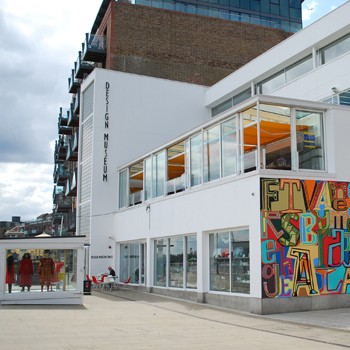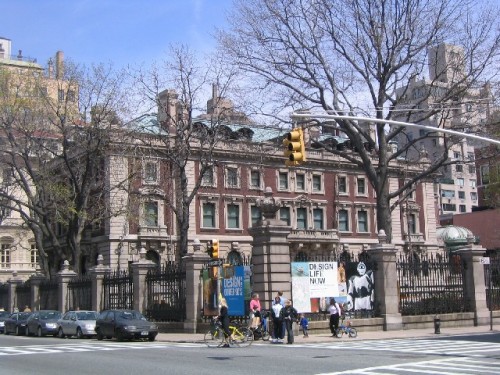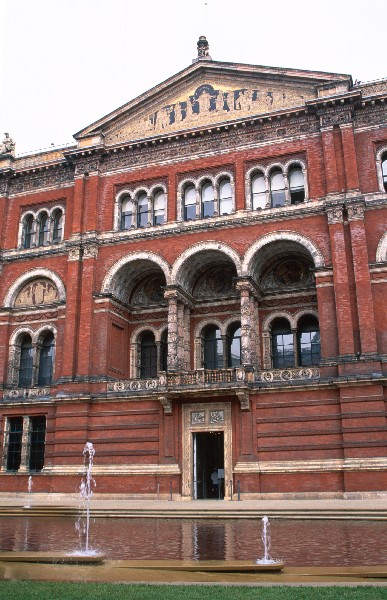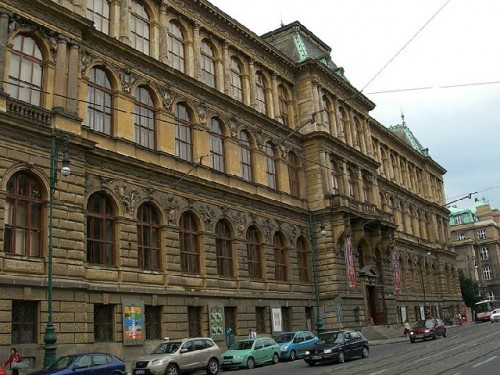Museum Madness In Boston
Moving Venues, Great Recession and Big Egos
By: Mark Favermann - Mar 17, 2010
The Great Recession has hampered much creative giving and general cultural institutional optimism. But, somehow a certain museum madness has overtaken the Boston area. Several groups, both establishment and independent are pushing for a museum of their own. The concepts or overall visions for a few are certainly questionable. The timing isn't good for any of them.
Traditionally, a museum is defined as a building or institution that houses a collection of objects or artifacts. Museums generally collect and care for objects of scientific, artistic or historical importance and make them available for public viewing. This is done by creating exhibits both temporary and permanent. A Kunsthalle is a German term for a facility for mounting temporary art exhibitions. Generally supported by an art association, an artists' collective or a local collector, very rarely they establish a permanent collection similar to a museum. However, these definitions are getting roughed up or at least a bit shredded by what's going on in Boston lately.
Two proposed (actually one has a bit of history) new "museums" are getting a lot of recent publicity and rather virtual visibility: Design Museum Boston and The New Center for Arts and Culture. Also, there are plans for an architectural and design museum sponsored by the the Boston Society of Architects (BSA) and the Boston Museum, an institution to showcase and teach about the history and culture of the City of Boston. Both mirror the other two proposed institutions in various ways. Rationally, collaboration would be the best direction for them, but egos get in the way.
Established in 1867, the Boston Society of Architects is the largest chapter of the American Institute of Architects. It is planning to open a new office, meeting center and museum of architecture and design at Russia Wharf during the Summer of 2011. Though the project is in the early stages, informational memos have started to be sent out, and committee meetings are being held to inform and seek input from architects and the community. The museum willl be called the Museum of Design and Architecture (MoDA). MoDA's mission, according to the BSA is to give the community insight into what is behind buildings and how neighborhoods are created in a hands-on, interactive cutting-edge way.
This sounds like a great idea, but there are many problems with it. First, the Great Recession has put many architects and designers out of work with a major downturn in development and construction. Would spending resources on a marginal museum anger the unemployed or underemployed membership? Second, there are limited funds and sponsors for such an ambitious undertaking. Who is going to pay for this? Third, the BSA is not and has not been in the museum field. In fact. they have very little space in which they actually exhibit competitions and thematic programs. Architecture is one thing, but do they or their 4000 members have the knowledge or even inclination to seriously exhibit other design disciplines? Timing and therefore financing just do not seem right now.
Currently, a lot of buzz is on for the Design Museum Boston. It is the two year old brainchild of two 27 year old designers, Sam Aquillano who works for Bose and the Derek Cascio who is a designer at Philips Color Kinetics. They bring a lot of youthful energy and inexperience to the task. The museum concept came out of a discussion about how to make the design community more vibrant and visible in Massachusetts. Soon they realized that the building or finding a suitable structure was out of the question due to financial constraints of the times. So, they focused upon empty storefronts, something that there seems a lot of right now in and around downtown Boston. The two want to create a nomadic museum bringing design to under used storefronts and shop windows.
Design Museum Boston will not be a traditional institution. Instead it will be at multiple sites scattered in many different retail spots. The first location or locations will be at Downtown Crossing. The exhibit will focus upon the Commonwealth of Massachusetts design history.
Future locations could include empty locations in malls, shopping strips and other "pop-up" locations. Designer Eliana Strauss will be challenged designing the exhibit spaces within the empty spaces. They envision a strong online component and are involved in the creation of an iPhone app to guide visitors. So far, they have raised around $10,000 for their endeavor, enough for a website and to assist with an exhibit to be shown at the Boston Redevelopment Authority (BRA) at Boston City Hall. But who is going to continue to pay for the object labels, shelving, pedestals and mounting surfaces?
According to Aquillano and Cascio, they have garnered verbal support from state officials and members of the design community. But talk is cheap. The creative economy needs to be economically viable. They hope to display objects, products and projects in nontraditional ways. But the danger in exhibiting design elements is that they can have a trade show, science fair or heavily retail (furniture showroom) feel unless sensitively and elegantly presented. Storefronts and shops underscore the store window, retail showroom motif. Hopefully the Design Museum Boston is not just another under supported and underfunded potentially interesting idea that is not carried out well. The two founders' youthful exuberance and design passion should not be wasted.
A note: There are two empty rooms at the McKim Building in the Boston Public Library's main branch that could get corporately or family branded (donor recognition) and be used for exhibitions, thus finding a home for serious design shows and helping the financially crippled library at the same time. Now, that would be an example of true creative economy.
In addition, there is already a thoughtful architectural/design gallery effort being created at pinkcommagallery. This gallery's mission is to foster and recognize a more creative and experimental scene that has grown out of one of the world's most significant centers of architectural and design education. To the gallery's founders, Boston's six architectural school's and their faculty have mentored and unleashed provocative figures on the world design scene. Their goal is to question why this design culture has not permeated the city's own architectural sense of self. They view their gallery as an independent venue to foster interest, education and thoughtful discourse. They also want to encourage the overall design community including all of the design disciplines.
Some of their rather visionary exhibits have included: Rethinking City Hall, September 2007; Prints Charming, December 2007; Close Encounters, October 2008; Rock, Paper, Scissors, December 2008; Concrete Toronto, May 2009; and Welcome Hometta, October 2009. Each had a futurist, non-establishment take on the architectural and design environment. Each exhibit has been very theoretical and/or academic. The gallery is owned by the design firm over, under. At least the Boston Society of Architects has shown the foresight to ask Chris Grimley, who along with Mark Pasnik are the directors of pinkcommagallery, to assist with their preliminary museum planning. There is certainly room in greater Boston for a number of creative approaches to showcasing architecture and design.
Like a slinky, design is an elegant object in movement that can come to a stop when not in play. The object can be fun, functional, elegant and even beautiful. Often taken for granted, undervalued and not properly recognized, design is a basic aspect of commerce, product development and of course branding. Discussions about a design museum in Boston have taken place at least since the early 1980's with nominal support from various design associations.
One group, the now long defunct Boston Design Council, worked cooperatively for a couple of years in the early 80s. It was made up of all of the professional design associations except for one. It had a series of cutting edge lectures at Harvard University's Science Building auditorium that included notable architects and designers from around the world. Each of the two lectures and panels were sold out. The Boston area's pent-up demand and interest in design was clear.
One distant goal of the group was to establish a Boston design museum. However, the Boston Design Council never was firmly established. Individual design organizations had their own agendas. The Boston Society of Architects never participated in the discussions. The ego of this architectural organization would not recognize the worth or equality of the other design disciplines-industrial design, graphic design, interior design or landscape architecture. With so many chiefs and the largest and richest organization not even returning calls, eventually, like the then stock market and over-extended large retailers, the Boston Design Council just faded away.
In the 90s, writing for another arts publication, I visited several art museums and made the case for more design exhibits. The case was built on the pent-up demand by students and practitioners, the lower cost of most exhibitions and the accessibility of design and architecture to the general public. Perhaps a legacy of this effort, the Boston Museum of Fine Arts schedules design-oriented shows every so often as does the ICA. There are no museum curators in Boston who are primarily design curators. The Rhode Island School of Design Museum has had a constant effort to showcase great design. Of course, the various design schools, if they have exhibition space, display design and architecture themed shows.
The strangest museum quest has been the New Center for Art and Culture. Initially, the New Center was to be a museum set on the much and appropriately maligned Rose Fitzgerald Kennedy Greenway. Starchitect Daniel Libeskind was chosen to create the $80 million building. It was to be a primarily geometric glass structure set near to Rowes Wharf. After several years of fanfare, the New Center's board announced recently that those plans are being abandoned. Even though they said that they were able to raise $20 million, not very surprising, they said that the turning away from the structure was due to the economy. The New Center is no longer a museum, but something else.
The New Center for Art and Culture came out of the vision of the late developer Edwin Sidman, formerly of The Beacon Companies, the former family (he was a son-in-law) owned development company that built Rowes Wharf, Ten Post Office Square and Center Plaza among others. After Mr. Sidman died, community support came from the Jewish Community Centers of Boston and the Combined Jewish Philanthropies of Greater Boston. Neither of these organizations had any background in museums.
The mission of the New Center was broadened beyond a Boston Jewish ethnic and immigrant experience to develop connections between and among groups in Boston that were historically separated by race, geography, ethnicity and religion through lectures, performances and exhibitions. This is all admirable, but extremely ambitious. The Libeskind museum was to bring focus to this effort. After several years of a moveable feast of cultural activities including lectures, temporary exhibits and events at a variety of venues including Boston College, The Boston Public Library and Boston University, now their mission is to model themselves after the 92nd Street Y in New York City. It is known and cherished for its high profile speeches, panels, courses and film showings. The venues will be rented and different depending on the needs of the events. This makes sense since the director of the New Center, Francine Achbar, was a longtime television producer rather than a museum professional.
A few years before the start of the New Center in 2001, another museum, the Boston Museum was begun in a small way in downtown Boston by among others former Governor Michael Dukakis and a number of prominent Boston establishment figures. This was literally to be a museum of the history and experience of the City of Boston. Not to be outdone by the New Center and its hiring of architect Libeskind, the Boston Museum hired locally based starchitect Moshe Safdie to design their facility on the Kennedy Greenway as well. Both designs were presented in 2004.
The Boston Museum has recently pulled back from its location on the Greenway stating that it was too difficult and costly to build at their designated site. So they are seeking permission to build at a less troubling location. To date, they have raised only $8 million of the needed $90 million for the project. So in other words, their good intentions are nowhere as well. This museum is a bit of a nonstarter.
The answer may be simple: collaboration. However, Boston egos are not easy to placate. The Boston Museum makes sense with New Center expanding programming and vision. A Boston venue (perhaps at Fort Point Channel) for history and diversity with a cultural and art context that combines the best of both institutional missions. Will collaboration work? Who knows? Nothing is easy in Boston. March museum madness may prevail for years, or could there be some Boston bracket busters that give us all a new perspective?










